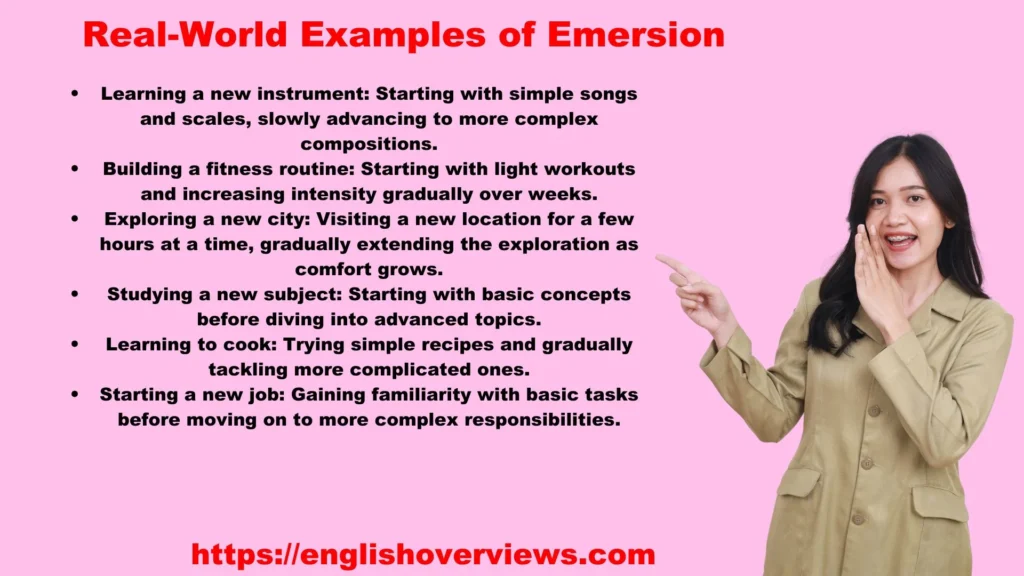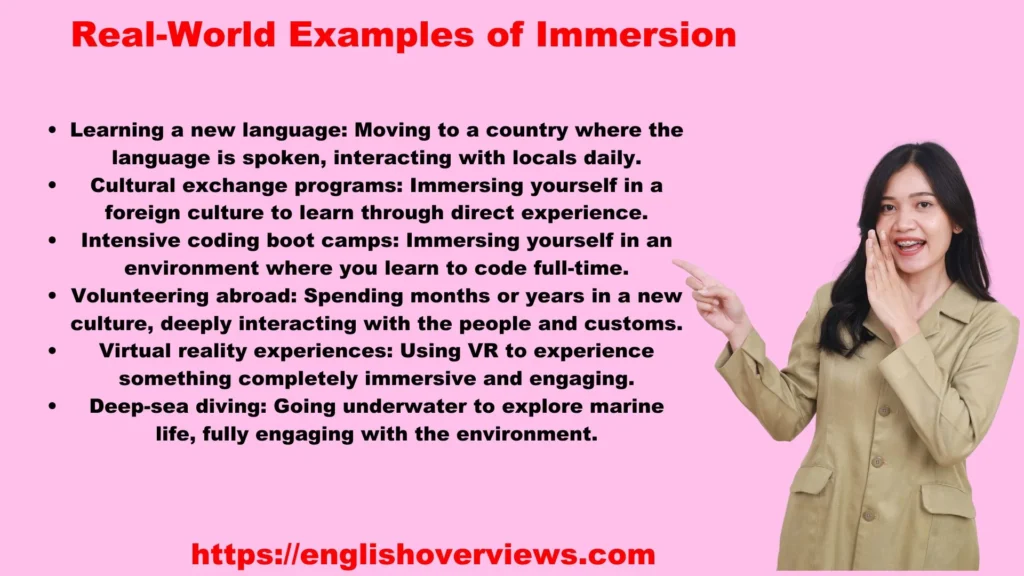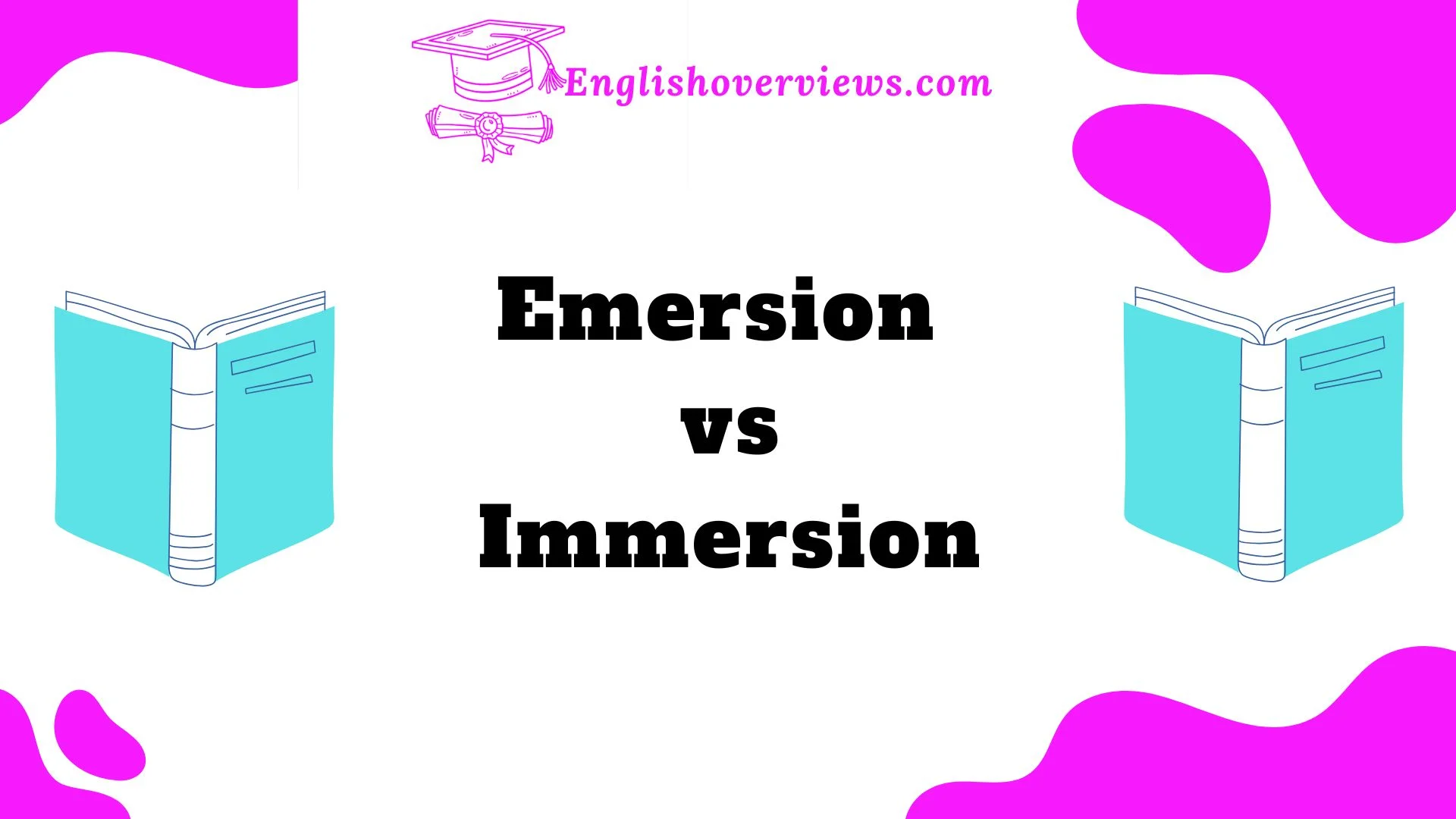Learning new skills, exploring cultures, or diving into unfamiliar topics can be thrilling yet challenging. Emersion vs immersion are two methods that can drastically transform how we experience and master the world around us.
But what exactly do these terms mean, and how can they help you grow? In this post, we’ll explore the differences between emersion and immersion, their practical applications, and when each method is best suited for your learning journey.
Whether you’re learning a language, developing a new skill, or embracing a new culture, understanding how these two methods work will give you a powerful edge in the learning process.
We’ll take a deep dive into real-world examples, case studies, and provide clear insights on when to use each approach for maximum results. So, let’s get started and unlock the secrets to transforming your learning experience!
What is Emersion?
Emersion is the process of gradually stepping into an experience, environment, or concept. It’s a slow yet consistent integration, allowing individuals to learn at their own pace.
Unlike immersion, where you’re thrown directly into the experience, emersion allows for a gentler, self-paced approach, enabling you to build familiarity and comfort over time.
In essence, emersion is about layering new information or experiences in a way that doesn’t overwhelm the learner.
It focuses on gradual exposure, often starting with basic concepts before advancing to more complex ones.
Key Characteristics of Emersion:
- Gradual exposure: You slowly ease into the experience, step by step.
- Self-paced learning: You control the speed at which you engage with new material.
- Personal growth: Emersion encourages reflection, learning from mistakes, and long-term growth.
For instance, if you wanted to learn a new language, emerson would involve starting with simple phrases or vocabulary, then expanding as your comfort grows. It’s not about diving headfirst into a new language, but about gradually building your skills over time.
Real-World Examples of Emersion

- Learning a new instrument: Starting with simple songs and scales, slowly advancing to more complex compositions.
- Building a fitness routine: Starting with light workouts and increasing intensity gradually over weeks.
- Exploring a new city: Visiting a new location for a few hours at a time, gradually extending the exploration as comfort grows.
- Studying a new subject: Starting with basic concepts before diving into advanced topics.
- Learning to cook: Trying simple recipes and gradually tackling more complicated ones.
- Starting a new job: Gaining familiarity with basic tasks before moving on to more complex responsibilities.
- Adopting a new technology: Using simple features first, then exploring more advanced ones as you become proficient.
- Creating a personal blog: Writing short posts at first, gradually increasing your writing output as you gain confidence.
- Learning to dance: Starting with basic steps, gradually learning more complex moves.
- Building relationships: Gradually opening up and spending more time with new friends or colleagues.
- Learning a new sport: Starting with basic movements, then progressing to more advanced techniques.
- Exploring new hobbies: Trying a variety of small projects to see what interests you most.
- Traveling abroad: Visiting a new destination for short trips before committing to long stays.
- Adopting a new health regimen: Slowly incorporating new habits into your routine over time.
- Joining a new community: Attending events and gradually getting involved in the group.
- Reading a new genre: Starting with short stories or easy books, moving on to novels as interest deepens.
- Improving time management: Starting with simple scheduling tools before moving on to complex productivity methods.
- Learning to meditate: Starting with short sessions, gradually increasing the time and depth of practice.
- Learning photography: Taking photos with basic settings and advancing as skills improve.
- Becoming a public speaker: Starting by speaking in small, familiar settings and gradually moving to larger audiences.
What is Immersion?
In contrast to emersion, immersion involves fully diving into an experience with little to no preparation. It’s about total engagement in an activity, often with the goal of gaining deep, authentic exposure quickly. Whether you’re learning a new skill or studying a subject, immersion forces you to adapt quickly, often without the gradual progression that emersion offers.
In the context of learning, immersion can sometimes feel intense, as you’re fully surrounded by the new language, environment, or experience. It’s about jumping in headfirst and learning through direct interaction and full engagement.
Key Characteristics of Immersion:
- Total engagement: You’re fully involved in the experience without holding back.
- Quick adaptation: You’re forced to adjust rapidly to the environment or task at hand.
- Immediate exposure: Immersion often happens right away, with little time to ease in.
For example, if you wanted to learn a language through immersion, you’d live in a country where that language is spoken, surrounded by native speakers at all times. This experience would force you to adapt quickly, providing constant exposure and real-world context for your learning.
Real-World Examples of Immersion

- Learning a new language: Moving to a country where the language is spoken, interacting with locals daily.
- Cultural exchange programs: Immersing yourself in a foreign culture to learn through direct experience.
- Intensive coding boot camps: Immersing yourself in an environment where you learn to code full-time.
- Volunteering abroad: Spending months or years in a new culture, deeply interacting with the people and customs.
- Virtual reality experiences: Using VR to experience something completely immersive and engaging.
- Deep-sea diving: Going underwater to explore marine life, fully engaging with the environment.
- High-intensity fitness programs: Engaging in boot camps where you are immersed in physical activity from the get-go.
- Mindfulness retreats: Spending days in silence, focusing deeply on meditation.
- Corporate training programs: Immersing yourself in a company culture by working on real-world projects with colleagues.
- Film studies: Watching multiple films from a genre or director to deeply understand their style.
- Performing arts: Immersing yourself in rehearsals and performances to develop your craft.
- Travel blogging: Immersing yourself in travel experiences to share insights in real-time.
- Cross-cultural cooking: Participating in an intensive culinary program to learn international dishes.
- Gaming communities: Becoming part of a gaming community by playing with others regularly, experiencing full engagement.
- Full-time study abroad: Living and studying in a foreign country to fully immerse yourself in the local culture and language.
- Music composition: Immersing yourself in music theory and composition by studying and creating full-time.
- Sports training camps: Immersing yourself in physical training, focusing solely on improving a particular sport.
- Social media marketing: Immersing yourself in digital marketing trends and live campaigns.
- Documentary filmmaking: Immersing yourself in the subject matter by spending time in the field, gathering firsthand footage.
- Extreme sports: Fully engaging in activities like skydiving, snowboarding, or rock climbing, with no prior experience.
Key Differences Between Emersion and Immersion
| Aspect | Emersion | Immersion |
| Approach | Gradual, step-by-step engagement | Total, immediate involvement |
| Pace | Self-paced, flexible | Fast-paced, full commitment |
| Learning Curve | Slower, with room for reflection | Quick, often intense |
| Suitability | Ideal for personal growth and gradual learning | Best for rapid mastery and total engagement |
| Example | Learning a new skill over time | Living in a new culture or country for full immersion |
When to Use Emersion vs. Immersion
Choosing between emersion and immersion depends on the type of experience you’re seeking. Here’s when each approach shines:
- Use Emersion when:
- You prefer a gradual approach to learning.
- You need time to process new information.
- You are building confidence or exploring new hobbies.
- You want flexibility in your learning process.
- Use Immersion when:
- You’re ready for intense exposure to a new subject or skill.
- You need to master something quickly or are in a time-sensitive situation.
- You want to fully commit to a new challenge or lifestyle.
- You thrive in highly engaging environments that demand focus and concentration.
Immersive Learning: Dive Deep into the World of Knowledge
Immersive learning is a method that combines the essence of immersion with educational experiences. It allows individuals to learn through interactive environments, making the process engaging and memorable.
This method is particularly useful in fields like medicine, engineering, and education, where real-world practice and application are key to mastery.
Benefits of Immersive Learning:
- Enhances retention of information by involving multiple senses.
- Provides a real-world context that is often lacking in traditional education.
- Helps learners develop critical thinking skills by placing them in realistic situations.
Embracing Novelty and Curiosity: The Power of Immersive Learning
Immersive learning thrives on curiosity and novelty. By stepping into an environment that is entirely new, learners can build deeper connections to the material, ensuring that lessons stick.
Novelty has been proven to trigger brain activity and enhance learning, making immersion a powerful tool for anyone looking to dive into a new subject.
Language Immersion: Unlocking New Worlds and Cultural Connections
Language immersion is one of the most effective ways to learn a new language quickly. By surrounding yourself with native speakers and engaging with the language in real-life contexts, you can accelerate your learning and gain an authentic understanding of the culture.
Benefits of Language Immersion:
- Faster fluency through constant exposure.
- Cultural understanding that goes beyond vocabulary and grammar.
- Real-world application of language skills in practical settings.
Conclusion: Choosing the Right Approach for Your Learning Journey
In the world of personal development, the choice between emersion and immersion comes down to your learning style, goals, and how quickly you want to achieve mastery.
Both methods offer unique benefits, but understanding their core differences will help you choose the one that fits your needs.
Emersion allows for a gradual, self-paced learning experience. It’s perfect for those who want to build confidence over time, avoid overwhelm, and enjoy a more reflective approach to new skills or experiences.
Whether you’re mastering a new hobby, language, or professional skill, emersion helps lay the foundation for long-term growth.
On the other hand, immersion is for those ready to dive headfirst into the deep end. It’s a more intense, engaging experience, designed for rapid adaptation and skill-building.
If you’re looking for quick mastery or want to be fully involved in a new environment, immersion is your best bet.
Both approaches have their place depending on the situation. You may even find that a combination of both methods works best for you at different stages of your learning journey.
Whatever path you choose, embracing either emersion or immersion will empower you to unlock new worlds of knowledge, culture, and personal growth.
FAQs
What is better for learning a new language, emersion or immersion?
For quick mastery, immersion is the way to go. If you want to build familiarity over time, emersion can be a good approach.
Can emersion lead to the same results as immersion?
While both methods are effective, immersion tends to lead to faster and deeper learning, especially in terms of practical skills.
How do I get started with immersion without overwhelming myself?
Start with small, manageable steps and gradually increase the intensity of the experience. For example, spend time with native speakers or watch content in the language.
What are some examples of immersion in everyday life?
Traveling abroad, living in a foreign culture, and using a new language in day-to-day interactions are all examples of immersion.
Can immersive learning techniques be used for self-improvement outside of academics?
Absolutely! Immersive techniques can be applied to personal development, such as learning new hobbies, fitness routines, or career skills.

English Overviews is a resourceful website dedicated to providing valuable content related to grammar and vocabulary. Muhammad Haroon has made notable contributions, sharing insights on various subjects, including WordPress themes and plugins. The primary goal of the site is to help users improve their English language skills effectively.











